Dual sport helmets are becoming more and more important for a couple of reasons. First and foremost, the adventure touring category of motorcycles is booming right now, and these helmets just look right aboard an adventure machine. Secondly, the practicality and versatility of these helmet designs are appreciated by many riders.
Last year, we tested a newly designed dual sport helmet from Arai, the XD4. An excellent design that was praised by our test rider, Shoei had a target to shoot for when it designed the new Hornet X2.
The Hornet X2 is actually being introduced tomorrow at the Washington, D.C. IMS show. Shoei invited several journalists to a Southern California unveiling yesterday in San Diego, however, and presented us with a sample that we have used to log a couple of hundred miles aboard a Husqvarna dual sport motorcycle, traversing fire roads and highways here in Southern California. More about our first impressions of the helmet later.
When you think about it, the design goals for any dual sport helmet have to share a couple of elements. First of all, it has to serve the purposes traditionally served by a helmet used in the dirt. These include incorporation of a sun visor, along with a space large enough to use goggles, if the rider chooses.
That big sun visor presents issues for the street, however, where high-speed aerodynamics and stability become extremely important. Additionally, that large opening which permits optional use of goggles, can pose challenges when it comes to creating a solid, airtight seal for the sun visor, in order to keep down wind noise at highway speeds.
The Hornet X2 incorporates a very carefully designed visor, which Shoei calls the V–460. According to Shoei, this visor spent countless hours of development in Shoei’s own wind tunnel, as well as on the road “to perfect the proper balance between aerodynamics and traditional visor functionality.”
The V–460 has an interesting shape incorporating prominent vent louvers, which Shoei claims reduces lift and drag during high-speed riding. This design also feeds air into the upper air intake of the helmet to aid cooling. The sunshade is quite effective, larger than the sunshade incorporated into Shoei’s previous design.
The new CNS-2 shield designed by Shoei offers a huge eye port, for excellent vision, including peripherally, and permitting the optional use of goggles by the rider.
As on other Shoei helmets, this new shield is very easily removed, even with the sunshade in place. Additionally, the rider can rotate the shield backward to its highest, open position,and put goggles in place. That’s right, you can wear goggles on the new Hornet X2 without even bothering to remove the shield (see photo). This could be quite convenient on a ride incorporating both highway and off-road sections.
Shoei also claims to have dramatically improved the ventilation and cooling in the new Hornet X2. Again, Shoei’s own in-house wind tunnel played a big role in its efforts to find the correct balance between airflow, low noise and functionality. The helmet includes a large multi–position lower air intake that aids in defrosting the interior of the shield. Also fed by upper air intakes, four exhaust outlets near the rear of the helmet, together with three neck outlets, take advantage of negative air pressure to remove hot air.
Now for the technical stuff, and the acronyms that go with them. The Hornet X2 features the “AIM+” shell that combines fiberglass and organic fibers to create strength while remaining lightweight. Four shell sizes help Shoei accommodate helmet sizes of XS through XXL. The Hornet X2 also features a dual-layer, multi-density EPS liner for impact absorption. Varying densities are used in key areas around the rider’s head, and tunnels through the EPS allow cooling air to travel unrestricted. A fully removable, washable and replaceable 3D Max-Dry Interior System II helps keep your helmet clean and comfortable.
Finally, the Hornet X2 features Shoei’s Emergency Quick Release System (EQRS) that assists emergency personnel in removing your helmet following a crash. The lower portion of the interior padding can be removed easily so that an injured rider can avoid further neck injuries when his helmet is slid off.
So here is the most interesting part. We tested the Hornet X2 aboard our Husqvarna FE 350 S test bike yesterday on a fairly long ride that covered high speed street, as well as off-road conditions. We are very impressed.
Given the size of the visor, it was remarkably aerodynamic . . . essentially, offering no noticeable impact on helmet stability at higher road speeds (tested up to roughly 75 mph). Shoei’s time in the wind tunnel has clearly paid off. Frankly, the Hornet X2 felt as stable, and quiet, as most high quality street helmets that do not feature an integrated visor!
We were also very impressed by the comfort of the Hornet X2. Shoei builds one of the nicer helmets, in general, but at the very top of this category we typically rate Arai as the most comfortable. The Hornet X2, depending on your head shape to some extent, should provide comfort comparable to top-of-the-line Arais. This is a big compliment in our book.
The interior felt more plush than our Shoei RF-1200, and we expect to be reaching for the Hornet X2 just about every time we board an adventure-style motorcycle. We will follow-up with more comments after further testing.
A couple of other items should be noted. The new shield system includes pinlocks allowing insertion of removable fog shields. Also, the visor itself can be removed easily and quickly without tools by rotating two locks on either side of the visor. This will give you a pure street look. Finally, the Hornet X2 is quite light, which is always a plus.
The Hornet X2 will be available in several solid and multi-colored graphic schemes. Solid colors are priced at $594.99, while metallic colors are $603.99 and multi-colored graphics are $715.99. Visit Shoei’s web site tomorrow for full information on the Hornet X2 (following the unveil at the Washington IMS show).
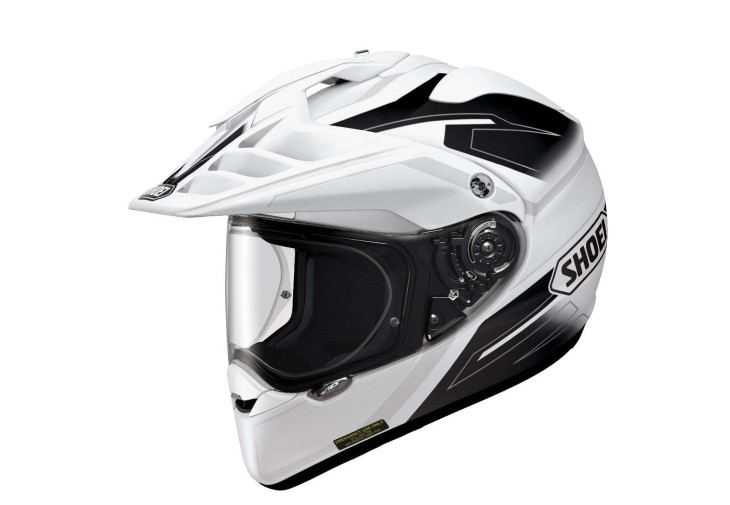
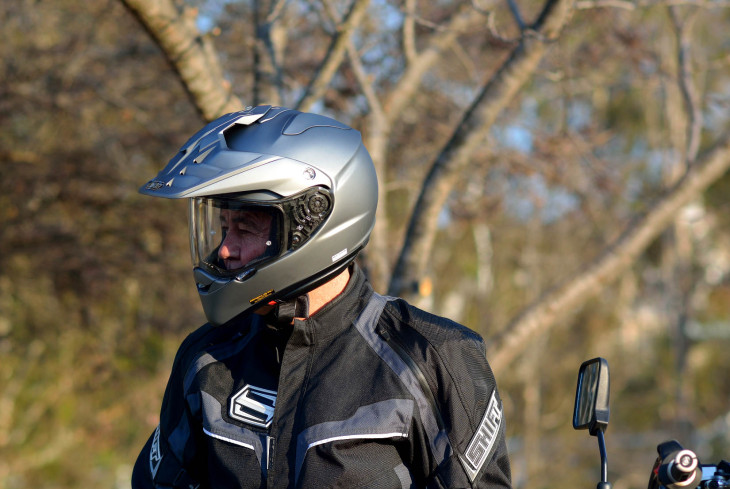
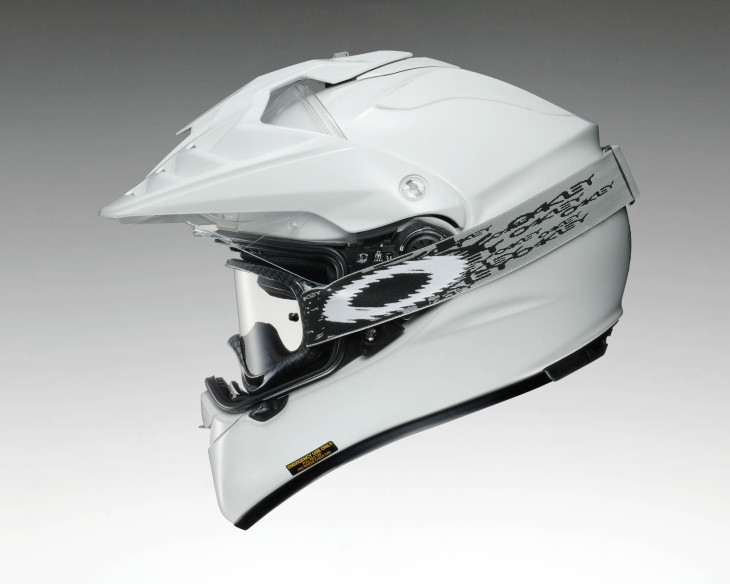
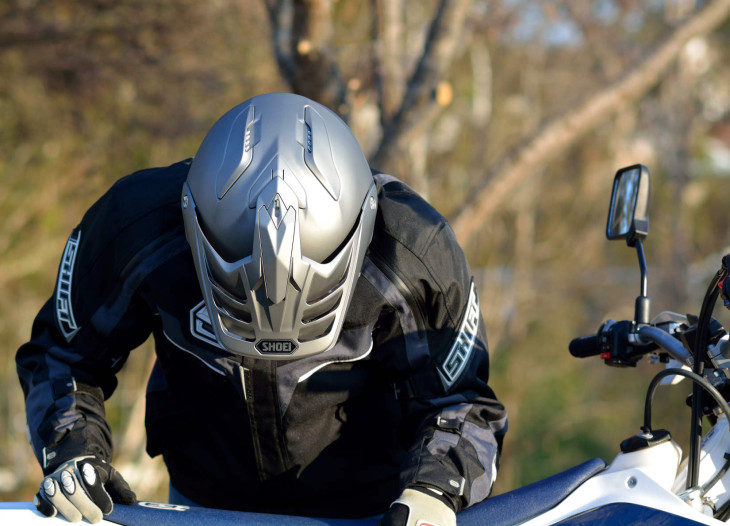
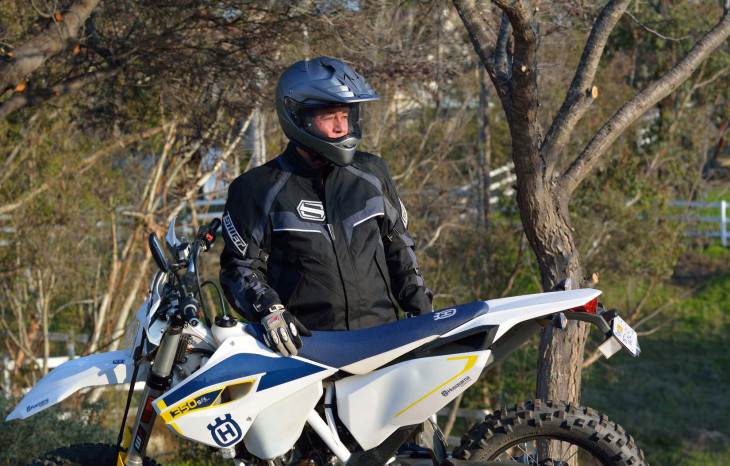






Do the air vents on the top let the rain in when you are stopped? or is it channeled away down your neck or something?? Do they seal in the closed position???
Pretty clear from the pics exactly where the water goes when it rains. In yer face.
“these helmets just look right aboard an adventure machine.”
Uhhh … no. Sorry. These helmets look dumb, no matter what you are riding.
You have a strip of black tape across the top of your visor, don’t you. 🙂
Ayup. Works great. Every five years I replace it with a fresh strip.
I’m more interested in hearing how well the Husky did as an Adventure Bike. Seems like a true 50/50 bike to me.
You guys talk to much, put on a damn helmet and go ride.
so why are you on here al? personally, I come here to read and learn about bikes & products. the more information I get allows me to be a better consumer and happier with my decision.
Exactly. And what else are we supposed to do while we are at work?
I’m retired. Rode 27,000 miles last year, so I ride a lot., but can’t ride all the time.
Ice musings:
In Dakota I can’t ride at this time of the year, so I ice fish. I wonder if the Husky would start at -20 F? I wonder if I’d have to use a snowmobile helmet to prevent fogging? Would ice spikes make me look like a poseur or would they “complete the package”? My electric vest is viewed as “sissified” but could the Husky handle it? If my beer freezes, does that mean I drink too slow?
Just wondering…
Thank you Shoei for a long awaited replacement for the hornet.
There is way too may opinions on this website without trial.
The visor is for roost, branches and occasional sun.
Its a dualsport helmet friends. Jack of all ,master of none.
Great right up.
Thanks
Using a regular style helmet dualsporting (or offroad) is always a compromise, that is if you actually leave the hard surface for the challenging (fun) terrain. Anyone who has ridden offroad (or dualsport) knows the visor has another very important function, namely to ward off the brush, branches etc. that hang over your path. You duck the visor under the obstructing objects and guide them up over your head instead of having them rake across you shield or neck. The lift issue is a concern but the testers seem to think that Shoei has addressed that well, so they clearly understand the concern, perhaps this will replace my current DS lid and go on the shelf beside the MX and Street helmets.
Was it tested in cross winds? I have a Hornet, no longer wear it as it is puts too much pressure on my neck when there is a cross wind. Worse helmet I have owned for that.
Beaks on bikes + beaks on lids = matched set! Who could want more?
I bought a cheap dual sport helmet a few years ago and it was the worst of both worlds. Loud as hell on the road and dusty in the dirt. I gave it away. If I’m riding serious off road I just use my dirt bike helmet with goggles.
Huh! Shift Racing street gear. Sadly no longer being manufactured.
In response to The Spaceman’s comment, unless you have a twig neck you will not get torqued when you twist your head at speed. I have a previous generation Shoei Hornet and it’s fine up to 110mph. I’ve turned my head at 85+ many times with little or no wind problems. If it fits it’s a quiet helmet. I do wear ear plugs all the time as I have done for 10+ years. windscreens, torso height, and personal sensitivity vary. This replacement model sounds even better except for that ever higher price tag.
How do you find it in cross winds though (strong winds) Mine is appalling, I no longer wear it.
I don’t care how much work they did in the wind tunnel; when you turn your head to clear a lane before moving over, that hat-beak is going to twist your neck like you were a terrorist in a “Replacements” movie.
Assumption vs. reality here.
I have worn Arai XD helmets (with similar visor design) while riding dozens of different bikes over many thousands of miles in various conditions. The “hat-beak” has never come close to “twisting my neck like…a terrorist”.
Also, the tester who wrote this piece after actually USING the helmet said as much.
Its all to do with aesthetics! If you want to look cool on the particular bike you ride…..go for it! A helmet is a helmet. The manufacturers are just giving you more options to use to take your money!
Yea,different helmets (and bikes)targeted at different types of riding is just the mans way of keeping you down!!
Attn. posers, this is the lid for you. My guess is the visor is for styling only. A short length of 3/4″ to 1″ Black Tape at the top of the shield works great as a visor and is lighter/cheaper/lower wind drag too. OK, the goggle function could be great off road and increased ventilation at lower speeds would be a plus. Just think how you would look at Starbucks.
“A short length of 3/4″ to 1″ Black Tape at the top of the shield works great as a visor and is lighter/cheaper/lower wind drag too. ”
Nothing says “I am a cheap douche” quite like black tape across your visor.
Seriously, though, the visors are great in my opinion. So is the black tape.
LOL! You mean it’s sort of like wearing old cowboy boots with your toes sticking out?
how does the black tape deflect roost or branches?
You and I know it doesn’t, now if it only would deflect silly comments then the rest of us could go ride our DS/Offroad/Adventure bikes
My X lid looks great at Starbucks. It also looks great on the highway, in a cross wind, on fire roads, single track, the occasional MX track, dunes, and the twisties all over Texas, Arkansas, Oklahoma, New Mexico, Colorado etc. I can even remove the visor if I don’t want people to know I’m a poser.
Ha!
This evolution of the sun shade / protruding “visor” has gone further with airflow and aerodynamics than the competition. This type of construction has significant limitations in dealing with sunlight at low angles ie dawn to ~ 9:00am and 3:00pm to ~ sunset.
My simple strategy for dealing with nuisance low angle sunlight is decent polarized sunglasses. A truly useful product without any aerodynamic issues would be a helmet visor incorporating polarizing filters plus shading density that varied with ambient light levels.
Please consider Mr Shoei and others …..
Very ducky
As mentioned, this breed of helmet goes aesthetically with the more off-road, adventure set. Good looking lid.
Then thoughts of you doing a rider test of a more “Outlaw” beanie cap type took over my thoughts. If I saw some large, burly, leather covered dude riding a dual-sport, sparks would fly! You’re right, there is a look meant for the type of rider and bike.
The proportions don’t look right.